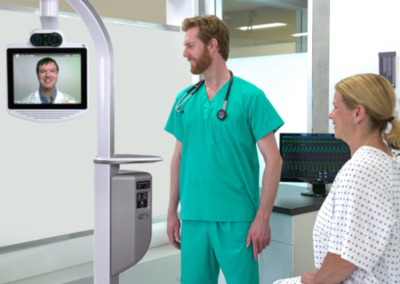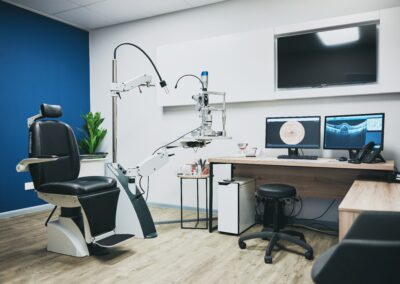‘The Consultant Connect service enables us to triage more effectively and, therefore, prioritise patients quickly.’
Since November 2024, clinicians within the Acute Medical Unit (AMU) have had the ability to seek specialist input from the Tissue Viability Team via Consultant Connect for wound management at the University Hospitals of North Midlands NHS Trust. Utilising the rapid and secure Photo Messaging Advice & Guidance service, AMU clinicians fill in the pre-set bespoke proforma within the Consultant Connect App or in their browser and can attach as many clinical images as needed to support with best patient care. We spoke with Katie Leek, Lead Nurse for Tissue Viability, and Emma Bennett, Senior Sister, to see how the new system has impacted their working methods.
Tissue Viability stats*:
More than 600 messages received | Queries responded to within one working day on average | 78% of messages resulted in the patient not requiring to see a tissue viability specialist
What led to the launch of the Tissue Viability Photo Messaging Advice & Guidance service?
‘We wanted image logs as soon as the patient started their hospital journey because referrals to the Tissue Viability Team historically had no photographic element, so it would be the subjective perception of the clinician who had seen the wound. Clinicians who aren’t specialists in tissue viability can find correctly categorising pressure damage challenging, so the ability to send photos for advice helps us pick out those more urgent cases. Consequently, we found that many of these referrals were inaccurate or unnecessary, which meant we spent a lot of time triaging when the process could be much more streamlined. Additionally, if damage, such as pressure ulcers, was acquired outside the hospital but wasn’t captured on arrival, the Trust often had to accept potential liability because we didn’t have those images from the front door.’
– Katie Leek, Lead Nurse for Tissue Viability.
What are the main benefits of this pathway?
‘It gives clinicians and their patients faster access to management plans, whilst reducing the number of referrals we receive. Before adding this service, the primary physician would refer the patient to us via Care Flow, and then we would go to the ward for an in-person assessment. For example, if we received a referral for what the clinician stated was a category three wound, but is actually category two moisture damage, that is a wound for which we can offer advice and don’t necessarily need to see or be involved in the management of.
‘Additionally, the patients who do need specialist tissue viability support receive faster care because of this pathway. The Consultant Connect service enables us to triage more effectively and, therefore, prioritise patients quickly.’
– Emma Bennett, Senior Sister.
‘Secondary benefits of the pathway are also that complaints around pressure ulceration are reduced, because when we can assess patients more quickly and explain conditions to the family, it helps them understand the complexities of the patient’s condition, which supports with enhanced care. We investigate hospital-acquired damage and deep-tissue injuries (DTIs), some of the most complex pressure ulcers, particularly during winter. Suppose a patient with a DTI is not captured on admission or is miscategorised, which is expected as they typically take 24-48 hours to present. In that case, we frequently must take responsibility for its acquisition, especially if the patient hasn’t been repositioned effectively. However, the primary clinician might not have been able to reposition the patient because they were acutely unwell or unstable, so if the patient picks up an infection or ends up with a category four DTI later down the line, that turns into a case review. This involves a Quality and Safety Team member creating a timeline for the patient’s hospital journey, and any clinician involved in that patient’s care has to attend the panel. We then review the case, identify the learning and produce actions, which is a lengthy and time-consuming process for damage that we haven’t caused, and is the responsibility of the community team. In more extreme cases, such as litigation, the Trust often ends up paying out for a wound that was acquired before admission, which is costly.’
– Katie Leek.
Patient example:
‘We recently triaged a patient via Consultant Connect where the primary clinician had indicated that he needed to be assessed as soon as possible, and we saw him within 24 hours of receiving the images. The gentleman had been admitted as a long lie after falling the night before. He had a septic chest infection and extensive deep-tissue injuries. The epidermis on his buttocks had already started to break down, and he had bilateral DTIs to his heels, as well as hyperkeratosis to his lower limbs. On arrival, the patient was agitated and in a lot of pain, so the benefit of us reviewing him quickly meant we could organise a specialist mattress for him and speak to his family.
‘The patient had been fit and well before the incident and, understandably, the family was shocked and anxious. We had a candid conversation about his pressure damage and the associated expectations. Unfortunately, the patient passed away, but the family were grateful for the honest conversation about his care, which is something that they might not have received had the pathway not been available. If we’d had a referral for this patient without the imagery, it would have been labelled “DTI to buttocks and heels”, and we might not have been able to assess and provide treatment for him as quickly as he needed. As a result, the family might have assumed that the pressure damage caused or contributed to his death, so speedier and enhanced engagement with the family is an obvious plus.’ – Katie Leek.
What are the plans for the future of the service?
‘In the long term, we would like to extend our provision to other areas of the Trust, like A&E and Care of the Elderly, but due to patient cohorts, this will add a significant workload to the team. During rollout, we worked with Brogan, our Account Manager, to tweak the outcome sets to make the data as comprehensive as possible. Consequently, the service is helping us identify gaps in our reach across the hospital, so if we had the resources, we’d like to advertise our flexibility to work with different teams and support shared care. To do this, we’re using our Consultant Connect data to build a business case for additional support. All our activity within Consultant Connect is tracked and, therefore, quantifiable, which will support with additional monies to develop part-time posts within the team to full-time posts.’
– Katie Leek.
Feedback from AMU
‘AMU introduced Consultant Connect to our unit to support the Tissue Viability Team, and to ensure accurate documentation of skin on arrival. As we are an Acute Medicine admission portal, we receive many acutely unwell patients, and, as part of the admission process, we inspect patients’ skin. As mentioned by the Tissue Viability Team, despite frequent training, classification and categorisation of skin damage is subjective to each staff member, and we often see inconsistent documentation and misinterpretation of damage. This results in the apparent deterioration of existing skin damage or hospital-acquired damaged that may not be correct. Capturing the skin using imaging on arrival has been beneficial to both our patients and staff, as we have been able to evidence this when defending against reported “hospital-acquired” skin damage when patients are transferred to the wards. Our patients receive a prompt review, either in person or virtually, so that our staff can manage the damage appropriately and earlier. From a quality perspective, this has helped to reduce our number of “hospital-acquired” pressure ulcers, as we can evidence the existence on arrival and prior to transfer to the wards that would have previously been miscategorised or poorly described/inconsistently documented. The roll out to our staff was relatively simple, with the support of Brogan and Olivia from the Consultant Connect Team, who supported with demos and training via MS Teams. Any issues with account support are promptly resolved by the team, meaning we can focus on our patients.’
– Gemma Aleksiewicz, Practice Development Nurse.
* Correct as of May 2025
If you have any questions, please get in touch on 01865 261467 or at hello@consultantconnect.org.uk.




